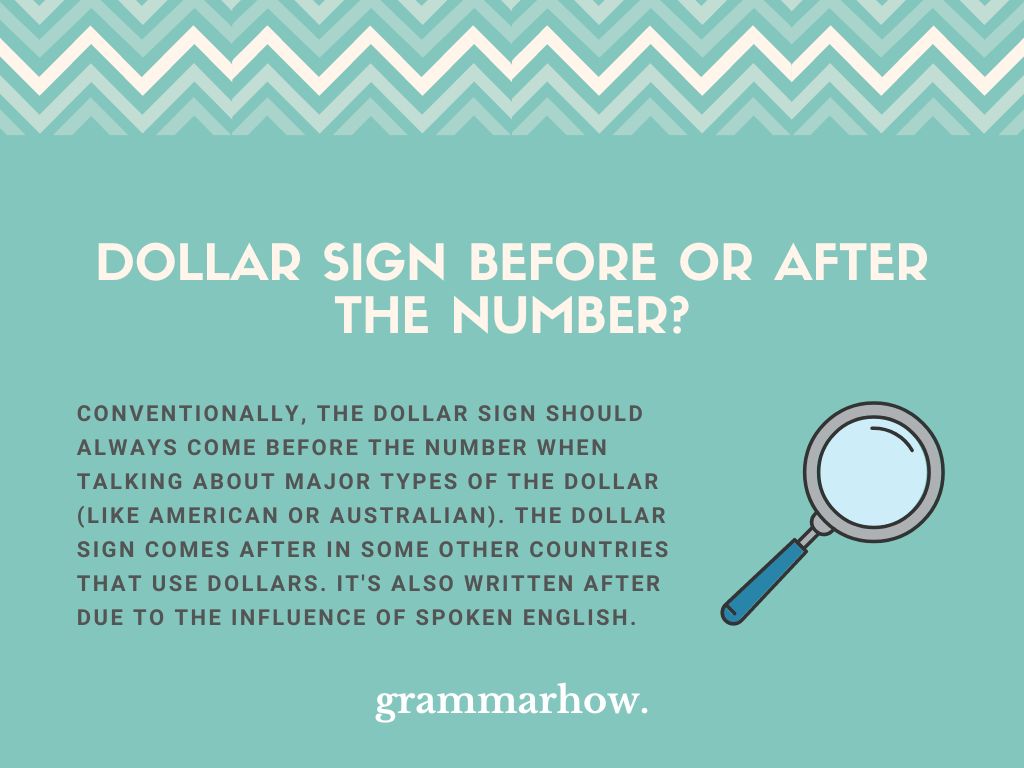Dollar signs can come up when you’re talking about money. Before you write anything to do with them, you should know a couple of things about where to place them. This article will explain all you need to know about whether a dollar sign comes before or after the number.
Dollar Sign Before or After the Number?
Conventionally, the dollar sign should always come before the number when talking about major types of the dollar (like American or Australian). The dollar sign comes after in some other countries that use dollars. It’s also written after due to the influence of spoken English.

In spoken English, you would say “three dollars.” However, it would conventionally be written as “$3.”
To some people (mainly non-native writers), this can be confusing. That’s why it’s fairly common to see the dollar symbol come after the word when these people write it. It makes more logical sense, so it can work well.
There are no fundamental rules that say where the dollar sign should be placed. It’s mainly based on convention and choice from the country that owns the dollar.
In major countries that have dollars as their currency, you’ll find this form:
- $20
- $100
- $1,500
In countries that don’t focus heavily on the dollar or to non-native speakers that prefer the symbol after the number, you might see the following:
- 20$
- 100$
- 1,500$
Dollar Sign Before the Number
You should almost always place the dollar sign before the number. If you’re referring to major dollar-based countries, this is the conventional choice. It’s the one that makes the most sense, and it’s the one that most people will understand.
You will find that this is true for most major currencies in the world. For example, the pound and the euro also come before the number in conventional terms.
If you want to see what it looks like when the dollar sign comes before the number in a sentence, you can refer to these examples:
- I’m going to need about $40 to get through today. Do you have anything that you can spare for me?
- It’s going to cost about $15. I don’t think we will need to split it, but I would appreciate some of your input.
- I’m not going to spend $6 dollars on a drink. There’s no way that something like this should cost that much.
- She asked me for $450, but I didn’t want to give it to her. I really didn’t see much of a reason for that.
Dollar Sign After the Number
You can place the dollar sign after the number when you are more comfortable with it. Generally, it comes before, but some non-native writers will place it after. This helps to keep it more true to how it would be said if read aloud, which is why it can work.
- She wanted to part with it for 400$, but I wasn’t about to spend that much money on it.
- He told me that he had 5$ in his wallet. Now, I’m finding out that he didn’t even bring it.
- The 10$ bill is easy enough to cover. I’ll sort that for you as soon as we’ve had our chat.
- It’s not just about the 1,000$ anymore. There’s so much to unpack here.
Is It Acceptable to Put the Dollar Sign after the Number?
Putting the dollar sign after the number is acceptable, but it’s not conventionally correct. You should follow the conventions of the country that uses the dollar. Since the US, Australia, and Canada are most famous for the dollar, it’s best to place the sign before the number.
If you’re not sure about which one works best, it’s almost always better to place the sign before. Most people will know what you’re trying to write about when you do it in this way.
With that said, there’s nothing wrong with placing the dollar sign after the fact. It is logical and makes sense, but most people avoid doing so out of conventional usage.
Final Thoughts
You can place the dollar sign before or after the number. For the most part, you should always place it before. This stays in line with conventional rules that state that currency signs should come before numbers (unless otherwise stated by a specific country or state).
You may also like:
How Do You Say Dollar Amounts? (Full Explanation)
Euro Symbol Before or After the Number? (20€ or €20)
How to Write Euros (Full Explanation with Examples)
How to Write USD Amount in Words (Full Explanation)
How to Write Negative Currency in Text (Negative Money)

Martin holds a Master’s degree in Finance and International Business. He has six years of experience in professional communication with clients, executives, and colleagues. Furthermore, he has teaching experience from Aarhus University. Martin has been featured as an expert in communication and teaching on Forbes and Shopify. Read more about Martin here.
